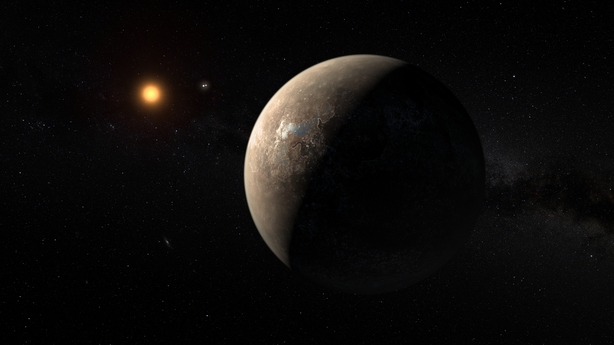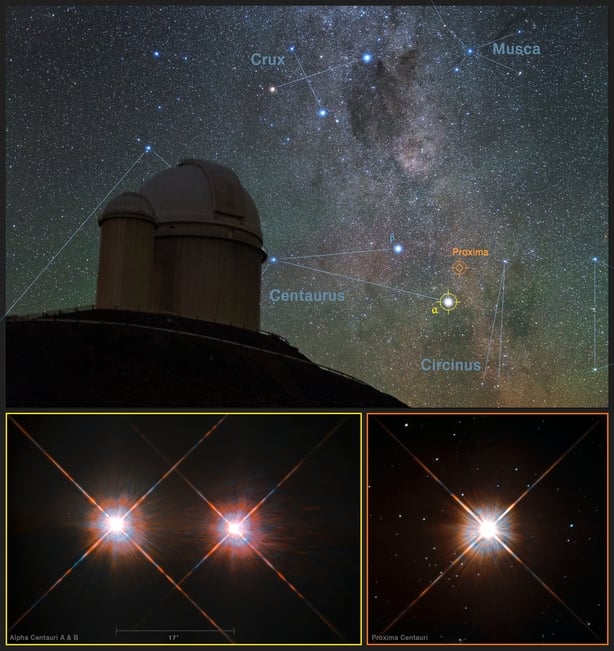Astronomers have discovered a new Earth-sized rocky planet that may have the potential to support life orbiting the closest star to our own solar system.
Proxima b is 1.3 times the mass of Earth, and it situated in a zone where scientists say it may be feasible for water to exist on its surface.

The exciting discovery has raised the prospect of the existence of a potentially habitable exoplanet that could in the future be reachable from our own home within a human lifetime.
The planet is orbiting Proxima Centauri, a low mass red dwarf situated a little over four lights years or 40 trillion kilometres from our solar system.
Red dwarfs are smaller than our Sun, and burn slowly, making them live for a long time.
Proxima b orbits its parent every 11.2 days and lies 7.5 million kilometres from it, a distance that is just 5 per cent of that between the Sun and Earth.
Despite its close proximity to the star, its faintness means scientists think the planet sits within the temperature range that would in theory enable liquid water to exist on the surface.
However, an answer to the question of whether or not it could sustain life is not clear, due to uncertainty around the planet's atmosphere and the likelihood of intense fluxes in harmful ultra-violet and X-ray flares due to its proximity to Proxima Centauri.
Proxima Centauri sits in the constellation of Centaurus and is too faint to be seen with the unaided eyes, but lies near to the much brighter pair of stars known as Alpha Centauri AB.
The scientists discovered the planet using measurements from the HARPS instrument on the 3.6m telescope at La Silla and the UVES instrument on the European Southern Observatory's Very Large Telescope in Paranal, both in Chile.
Other instruments were also used to verify the data.
The 31 person team, led by Dr Guillem Anglada-Escudé of the Queen Mary, University of London, used doppler data collected between 2000 and 2014, as well as fresh observations over 60 nights between January and March this year.
The concerted campaign, called Pale Red Dot, aimed to confirm previous indications of the existence of a planet at Proxima Centauri.
In research published in the journal Nature, they decribe how they noticed the tiny movements or wobble of Proxima Centauri light spectrum, caused by the gravitational pull of Proxima b.

"Once we had established that the wobble wasn't caused by star spots, we knew that that there must be a planet orbiting within a zone where water could exist, which is really exciting," said co-author Dr John Barnes, from the Open University.
"If further research concludes that the conditions of its atmosphere are suitable to support life, this is arguably one of the most important scientific discoveries we will ever make."
The announcement that the planet has been found has been a long-time coming, with initial observations made 15 years ago, and scientific papers on the topic first submitted for peer review in 2013.
"Succeeding in the search for the nearest terrestrial planet beyond the Solar system has been an experience of a lifetime, and has drawn on the dedication and passion of a number of international researchers," Dr Anglada-Escudé said.
"We hope these findings inspire future generations to keep looking beyond the stars. The search for life on Proxima b comes next."
Such a search may involve the use of robotic probes which can travel quickly to the huge distance to the planet to take measurements.
Project Startshot, backed by Russian billionaire Yuri Milner, is planning to send high speed nanocraft driven by large sails propelled by lasers from Earth to Alpha Centauri in the coming years.
The project team is also not ruling out the possibility that there may be more than one planet orbiting the star, because they have observed another signal which has not yet been verified.
"We have high expectations that this is a multi-planet system, so we keep looking," said Dr Angldad-Escudé.

